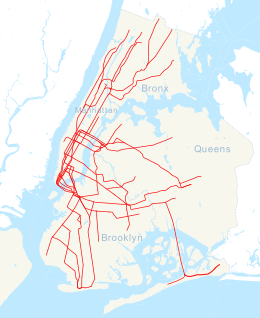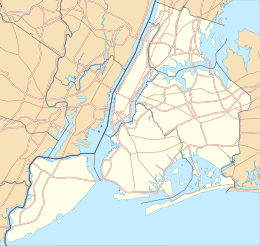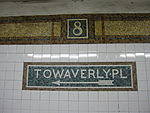railroad.wikisort.org - Station
The Eighth Street–New York University station (sometimes shortened as 8th Street–NYU) is a local station on the New York City Subway's BMT Broadway Line. Located at the intersection of Eighth Street and Broadway in Greenwich Village, Manhattan, it is served by the R train at all times except late nights, the W train on weekdays, the N train during late nights and weekends, and the Q train during late nights.
8 Street–New York University | ||||||||||||||||||||||||||||||||||||||||||||||||||||||||||||||||||||
|---|---|---|---|---|---|---|---|---|---|---|---|---|---|---|---|---|---|---|---|---|---|---|---|---|---|---|---|---|---|---|---|---|---|---|---|---|---|---|---|---|---|---|---|---|---|---|---|---|---|---|---|---|---|---|---|---|---|---|---|---|---|---|---|---|---|---|---|---|
 Platform for downtown trains | ||||||||||||||||||||||||||||||||||||||||||||||||||||||||||||||||||||
| Station statistics | ||||||||||||||||||||||||||||||||||||||||||||||||||||||||||||||||||||
| Address | East 8th Street & Broadway New York, NY 10003 | |||||||||||||||||||||||||||||||||||||||||||||||||||||||||||||||||||
| Borough | Manhattan | |||||||||||||||||||||||||||||||||||||||||||||||||||||||||||||||||||
| Locale | Greenwich Village, NoHo | |||||||||||||||||||||||||||||||||||||||||||||||||||||||||||||||||||
| Coordinates | 40.730543°N 73.992448°W | |||||||||||||||||||||||||||||||||||||||||||||||||||||||||||||||||||
| Division | B (BMT)[1] | |||||||||||||||||||||||||||||||||||||||||||||||||||||||||||||||||||
| Line | BMT Broadway Line | |||||||||||||||||||||||||||||||||||||||||||||||||||||||||||||||||||
| Services | N Q R W | |||||||||||||||||||||||||||||||||||||||||||||||||||||||||||||||||||
| Transit | ||||||||||||||||||||||||||||||||||||||||||||||||||||||||||||||||||||
| Structure | Underground | |||||||||||||||||||||||||||||||||||||||||||||||||||||||||||||||||||
| Platforms | 2 side platforms | |||||||||||||||||||||||||||||||||||||||||||||||||||||||||||||||||||
| Tracks | 4 | |||||||||||||||||||||||||||||||||||||||||||||||||||||||||||||||||||
| Other information | ||||||||||||||||||||||||||||||||||||||||||||||||||||||||||||||||||||
| Opened | September 4, 1917[2] | |||||||||||||||||||||||||||||||||||||||||||||||||||||||||||||||||||
| Opposite- direction transfer | No | |||||||||||||||||||||||||||||||||||||||||||||||||||||||||||||||||||
| Former/other names | 8th Street-NYU | |||||||||||||||||||||||||||||||||||||||||||||||||||||||||||||||||||
| Traffic | ||||||||||||||||||||||||||||||||||||||||||||||||||||||||||||||||||||
| 2019 | 5,434,212[3] | |||||||||||||||||||||||||||||||||||||||||||||||||||||||||||||||||||
| Rank | 82 out of 424[3] | |||||||||||||||||||||||||||||||||||||||||||||||||||||||||||||||||||
| ||||||||||||||||||||||||||||||||||||||||||||||||||||||||||||||||||||
| ||||||||||||||||||||||||||||||||||||||||||||||||||||||||||||||||||||
| ||||||||||||||||||||||||||||||||||||||||||||||||||||||||||||||||||||
| ||||||||||||||||||||||||||||||||||||||||||||||||||||||||||||||||||||
| ||||||||||||||||||||||||||||||||||||||||||||||||||||||||||||||||||||
History
Construction and opening
The New York Public Service Commission adopted plans for what was known as the Broadway–Lexington Avenue route on December 31, 1907. This route began at the Battery and ran under Greenwich Street, Vesey Street, Broadway to Ninth Street, private property to Irving Place, and Irving Place and Lexington Avenue to the Harlem River. After crossing under the Harlem River into the Bronx, the route split at Park Avenue and 138th Street, with one branch continuing north to and along Jerome Avenue to Woodlawn Cemetery, and the other heading east and northeast along 138th Street, Southern Boulevard, and Westchester Avenue to Pelham Bay Park. In early 1908, the Tri-borough plan was formed, combining this route, the under-construction Centre Street Loop Subway in Manhattan and Fourth Avenue Subway in Brooklyn, a Canal Street subway from the Fourth Avenue Subway via the Manhattan Bridge to the Hudson River, and several other lines in Brooklyn.[4][5]
The Brooklyn Rapid Transit Company submitted a proposal to the Commission, dated March 2, 1911, to operate the Tri-borough system (but under Church Street instead of Greenwich Street), as well as a branch along Broadway, Seventh Avenue, and 59th Street from Ninth Street north and east to the Queensboro Bridge; the Canal Street subway was to merge with the Broadway Line instead of continuing to the Hudson River. The city, the BRT, and the Interborough Rapid Transit Company (which operated the first subway and four elevated lines in Manhattan) came to an agreement, and sent a report to the New York City Board of Estimate on June 5, 1911. The line along Broadway to 59th Street was assigned to the BRT, while the IRT obtained the Lexington Avenue line, connecting with its existing route at Grand Central–42nd Street. Construction began on Lexington Avenue on July 31, and on Broadway the next year. The Dual Contracts, two operating contracts between the city and the BMT and IRT, were adopted on March 4, 1913.[6]
A short portion of the line, coming off the north side of the Manhattan Bridge through Canal Street to 14th Street–Union Square, opened on September 4, 1917, at 2 P.M., with an eight car train carrying members of the Public Service Commission, representatives of the city government and officials of the BRT, leaving Union Square toward Coney Island. Service opened to the general public at 8 P.M., with trains leaving Union Square and Coney Island simultaneously.[7] The line was served by two services. One route ran via the Fourth Avenue Line and the Sea Beach Line to Coney Island, while the other line, the short line, ran to Ninth Avenue, where passengers could transfer for West End and Culver Line service. The initial headway on the line was three minutes during rush hours, three minutes and forty-five seconds at other times, except during late nights when service ran every fifteen minutes.[8]
Later years
The city government took over the BMT's operations on June 1, 1940.[9][10] The station's overhaul in the late 1960s included extending the station platforms required for 10 car trains, and fixing the station's structure and the overall appearance (including the staircases and platform edges), replacing the original wall tiles, old signs, and incandescent lighting to the 70's modern look wall tile band and tablet mosaics, signs and fluorescent lights.
In 2001, the station received a state of repairs including upgrading the station for ADA compliance and restoring the original late 1910s tiling, repairing the staircases, re-tiling for the walls, new tiling on the floors, upgrading the station's lights and the public address system, installing ADA yellow safety threads along the platform edge, new signs, and new trackbeds in both directions.
In 2005, the artwork Tim Snell's Broadway Diary mosaics installed on the station platform wall titles in both directions.
Station layout

| G | Street level | Exit/entrance |
| P Platform level |
Side platform | |
| Northbound local | ← ← ← ← | |
| Northbound express | ← | |
| Southbound express | | |
| Southbound local | | |
| Side platform | ||
This underground station has four tracks and two side platforms. The inner two tracks are express tracks that do not serve the station.
Exits
The staffed fare control for each platform is at platform level at the center of each platform. There is no free transfer between directions. Outside of fare control, the northbound platform has one street stair to each eastern corner of Broadway and Eighth Street, while the southbound platform has two street stairs to each western corner of that intersection.[11]
Near the southern ends of each platform, one stair ascends from each platform to an intermediate landing on each side. Each landing has an exit-only turnstile and a HEET turnstile. The exits then ascend to their respective northern corners of Broadway and Waverly Place (the southbound platform's exit to the northwest corner, the northbound platform's exit to the northeast corner).[11]
References
- "Glossary". Second Avenue Subway Supplemental Draft Environmental Impact Statement (SDEIS) (PDF). Vol. 1. Metropolitan Transportation Authority. March 4, 2003. pp. 1–2. Archived from the original (PDF) on February 26, 2021. Retrieved January 1, 2021.
- "Open First Section of Broadway Line". The New York Times. September 5, 1917.
- "Facts and Figures: Annual Subway Ridership 2014–2019". Metropolitan Transportation Authority. 2020. Retrieved May 26, 2020.
- James Blaine Walker, Fifty Years of Rapid Transit, 1864–1917, published 1918, pp. 207-223
- Engineering News, A New Subway Line for New York City, Volume 63, No. 10, March 10, 1910
- James Blaine Walker, Fifty Years of Rapid Transit, 1864–1917, published 1918, pp. 224-241
- "Broadway Subway Opened To Coney By Special Train. Brooklynites Try New Manhattan Link From Canal St. to Union Square. Go Via Fourth Ave. Tube". The Brooklyn Daily Eagle. September 4, 1917. Retrieved May 31, 2019.
- "Open First Section Of Broadway Line; Train Carrying 1,000 Passengers Runs from Fourteenth Street to Coney Island. Regular Service Begins. New Road Is Expected to Relieve Old System of 15,000 PersonsDaily in Rush Hours. Service Commissioners Jubliant. Schedule Not Fully Arranged". The New York Times. September 5, 1917. ISSN 0362-4331. Retrieved November 5, 2016.
- "B.M.T. Lines Pass to City Ownership; $175,000,000 Deal Completed at City Hall Ceremony-- Mayor 'Motorman No. 1'". The New York Times. 1940-06-02. ISSN 0362-4331. Archived from the original on July 19, 2021. Retrieved 2022-05-14.
- "City Takes Over B. M. T. System; Mayor Skippers Midnight Train". New York Herald Tribune. June 2, 1940. p. 1. ProQuest 1243059209.
- "MTA Neighborhood Maps: East Village" (PDF). Metropolitan Transportation Authority. 2015. Retrieved August 6, 2015.
External links
- nycsubway.org – BMT Broadway Subway: 8th Street
- Station Reporter – N Train
- Station Reporter – R Train
- Flickr – Photo of Tim Snell's Cube mural
- Wired New York Forum – Subway mosaics and their artists
- MTA's Arts For Transit – 8th Street–NYU (BMT Broadway Line)
- Eighth Street entrance from Google Maps Street View
- Waverly Place entrance from Google Maps Street View
- Platforms from Google Maps Street View
На других языках
- [en] Eighth Street–New York University station
[ru] Восьмая улица — Нью-Йоркский университет (линия Бродвея, Би-эм-ти)
«Восьмая улица — Нью-Йоркский университет» (англ. Eighth Street–New York University) — станция Нью-Йоркского метрополитена, расположенная на линии Бродвея, Би-эм-ти. Станция находится в Манхэттене, в округе Гринвич-Виллидж, на пересечении Бродвея с 8-й улицей. На станции останавливаются маршруты: N (ночью и в выходные), Q (ночью), R (круглосуточно, кроме ночи) и W (в будни днём и вечером до 23:00). Станцию проходят без остановки маршруты N (в будни днём и вечером) и Q (круглосуточно, кроме ночи). Эта станция — ближайшая к Нью-Йоркскому университету.Другой контент может иметь иную лицензию. Перед использованием материалов сайта WikiSort.org внимательно изучите правила лицензирования конкретных элементов наполнения сайта.
WikiSort.org - проект по пересортировке и дополнению контента Википедии





